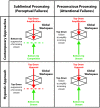Elucidating unconscious processing with instrumental hypnosis
- PMID: 25120504
- PMCID: PMC4112913
- DOI: 10.3389/fpsyg.2014.00785
Elucidating unconscious processing with instrumental hypnosis
Abstract
Most researchers leverage bottom-up suppression to unlock the underlying mechanisms of unconscious processing. However, a top-down approach - for example via hypnotic suggestion - paves the road to experimental innovation and complementary data that afford new scientific insights concerning attention and the unconscious. Drawing from a reliable taxonomy that differentiates subliminal and preconscious processing, we outline how an experimental trajectory that champions top-down suppression techniques, such as those practiced in hypnosis, is uniquely poised to further contextualize and refine our scientific understanding of unconscious processing. Examining subliminal and preconscious methods, we demonstrate how instrumental hypnosis provides a reliable adjunct that supplements contemporary approaches. Specifically, we provide an integrative synthesis of the advantages and shortcomings that accompany a top-down approach to probe the unconscious mind. Our account provides a larger framework for complementing the results from core studies involving prevailing subliminal and preconscious techniques.
Keywords: consciousness; global workspace; instrumental hypnosis; preconscious processing; subliminal perception; suggestion; suppression of consciousness; unconscious.
Figures





Similar articles
-
[The unconscious and hypnosis].Ann Med Psychol (Paris). 1980 May;138(5):529-42. Ann Med Psychol (Paris). 1980. PMID: 7001980 French.
-
Conscious, preconscious, and subliminal processing: a testable taxonomy.Trends Cogn Sci. 2006 May;10(5):204-11. doi: 10.1016/j.tics.2006.03.007. Epub 2006 Apr 17. Trends Cogn Sci. 2006. PMID: 16603406
-
Conscious intelligence is overrated: The normative unconscious and hypnosis.Am J Clin Hypn. 2022 Apr;64(4):290-305. doi: 10.1080/00029157.2021.2025032. Epub 2022 Mar 8. Am J Clin Hypn. 2022. PMID: 35259073 Review.
-
Unconscious integration: Current evidence for integrative processing under subliminal conditions.Br J Psychol. 2023 May;114(2):430-456. doi: 10.1111/bjop.12631. Epub 2023 Jan 23. Br J Psychol. 2023. PMID: 36689339 Review.
-
The cognitive unconscious.Science. 1987 Sep 18;237(4821):1445-52. doi: 10.1126/science.3629249. Science. 1987. PMID: 3629249
Cited by
-
The top-down regulation from the prefrontal cortex to insula via hypnotic aversion suggestions reduces smoking craving.Hum Brain Mapp. 2019 Apr 15;40(6):1718-1728. doi: 10.1002/hbm.24483. Epub 2018 Nov 22. Hum Brain Mapp. 2019. PMID: 30467911 Free PMC article.
-
Invisible, but how? The depth of unconscious processing as inferred from different suppression techniques.Front Psychol. 2014 Oct 1;5:1117. doi: 10.3389/fpsyg.2014.01117. eCollection 2014. Front Psychol. 2014. PMID: 25324817 Free PMC article. No abstract available.
-
Hypnotic State Modulates Sensorimotor Beta Rhythms During Real Movement and Motor Imagery.Front Psychol. 2019 Oct 22;10:2341. doi: 10.3389/fpsyg.2019.02341. eCollection 2019. Front Psychol. 2019. PMID: 31695643 Free PMC article.
-
Consciousness: individuated information in action.Front Psychol. 2015 Jul 29;6:1035. doi: 10.3389/fpsyg.2015.01035. eCollection 2015. Front Psychol. 2015. PMID: 26283987 Free PMC article.
-
Can hypnosis displace the threshold for visual consciousness?Neurosci Conscious. 2018 Nov 20;2018(1):niy009. doi: 10.1093/nc/niy009. eCollection 2018. Neurosci Conscious. 2018. PMID: 30488004 Free PMC article.
References
-
- Baars B. J. (1988). A Cognitive Theory of Consciousness. Cambridge: Cambridge University Press
LinkOut - more resources
Full Text Sources
Other Literature Sources

